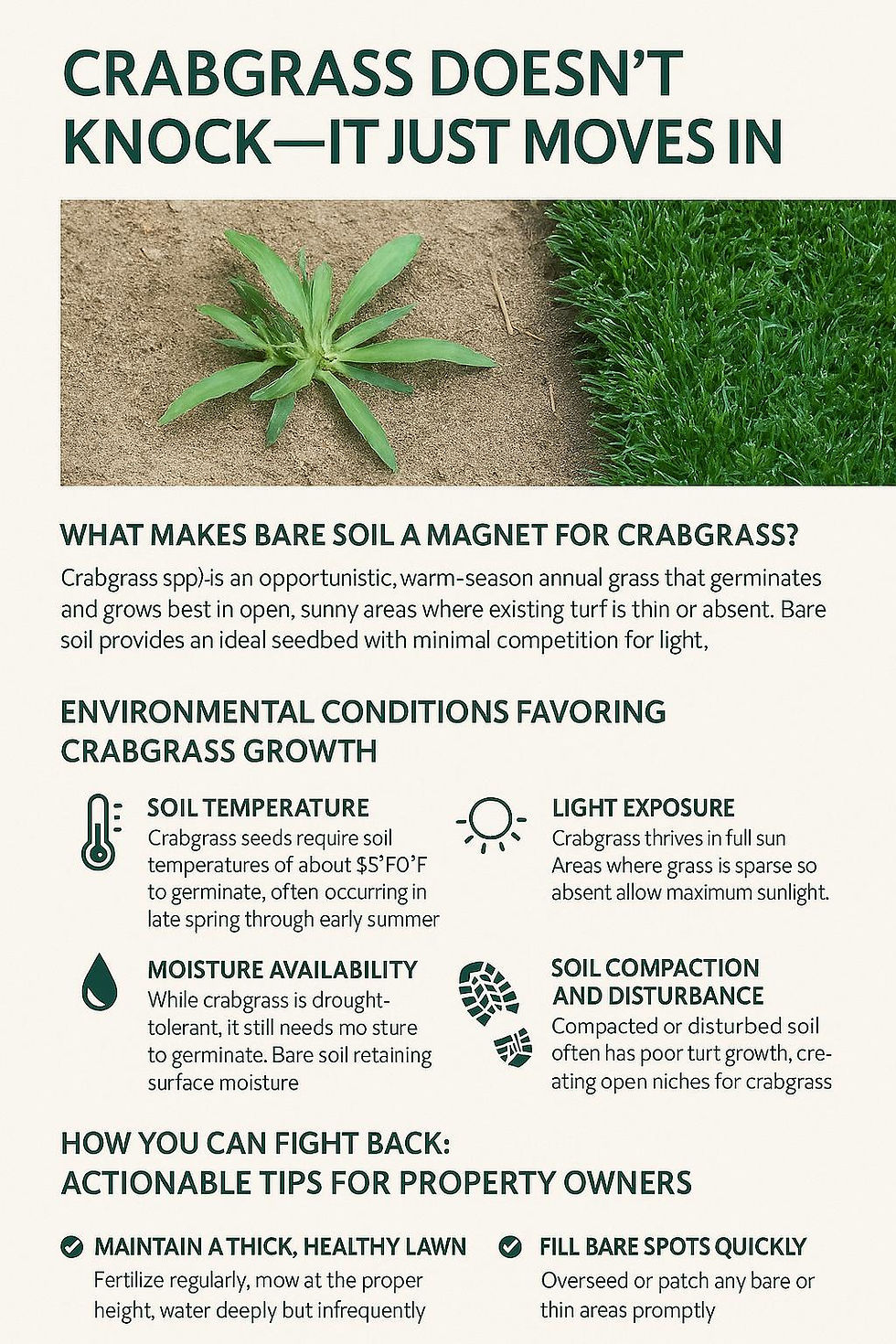Crabgrass Doesn’t Knock—It Just Moves In
- Joseph Pacocha

- Jul 30
- 2 min read
If you’ve noticed crabgrass rapidly spreading in bare patches of your lawn this summer, you’re not alone. This invasive weed is a common problem across the northwest suburban Chicago area, and understanding why it thrives in these spots can help you take effective action.
What Makes Bare Soil a Magnet for Crabgrass?
Crabgrass (Digitaria spp.) is an opportunistic, warm-season annual grass that germinates and grows best in open, sunny areas where existing turf is thin or absent. Bare soil provides an ideal seedbed with minimal competition for light, nutrients, and moisture.

Environmental Conditions Favoring Crabgrass Growth
Soil Temperature: Crabgrass seeds require soil temperatures of about 55°F to 60°F to germinate, often occurring in late spring through early summer in our region. Bare soil heats up more quickly and consistently than shaded or covered soil, accelerating crabgrass germination.
Light Exposure: Crabgrass thrives in full sun. Areas where grass is sparse or absent allow maximum sunlight, giving crabgrass seedlings a competitive advantage over slower-growing cool-season grasses.
Moisture Availability: While crabgrass is drought-tolerant, it still needs moisture to germinate. Bare soil that retains surface moisture after rain or irrigation can be a perfect environment for crabgrass seed to sprout.
Soil Compaction and Disturbance: Compacted or disturbed soil often has poor turf growth, creating open niches for crabgrass. Such soil conditions reduce root penetration and water infiltration, weakening desirable grasses and making it easier for crabgrass to establish.
The Lifecycle Advantage
Crabgrass is an annual grass that completes its life cycle in one growing season, producing thousands of seeds that remain viable in the soil seed bank for years. When turf is damaged or bare, crabgrass seeds lying dormant in the soil quickly germinate and colonize these open spaces before other grasses can recover.
How You Can Fight Back: Actionable Tips for Property Owners
Maintain a Thick, Healthy Lawn: Fertilize regularly, mow at the proper height (around 3 inches), and water deeply but infrequently to encourage strong turf that crowds out crabgrass.
Fill Bare Spots Quickly: Overseed or patch any bare or thin areas promptly to reduce open soil that crabgrass can invade.
Aerate Compacted Areas: Core aeration improves soil structure, making it easier for grass roots to grow and outcompete weeds.
Use Pre-Emergent Herbicides: These products, applied in early spring, prevent crabgrass seeds from germinating. Timing is critical—too late and they won’t be effective.
Targeted Post-Emergent Treatments: For crabgrass that has already sprouted, selective herbicides can help control and reduce its spread.

Professional Lawn Care Solutions to Combat Crabgrass
Our experienced lawn care team at Pacocha Landscaping Services, Inc. offers customized programs designed to:
Assess your lawn’s specific crabgrass risk areas
Apply professionally timed pre-emergent and post-emergent treatments
Aerate, mechanically slit-seed and/or add top soil and seed to repair damage and promote thick, healthy turf
Provide ongoing monitoring and maintenance to keep crabgrass at bay year-round
Don’t Let Crabgrass Take Over Your Lawn
By understanding why crabgrass thrives and taking proactive steps, you can protect your lawn’s health and beauty. If crabgrass has already become a problem or you want to prepare your lawn for next season, contact us today for a consultation and customized treatment plan.
Thank you for visiting our website and have a great day!







Comments